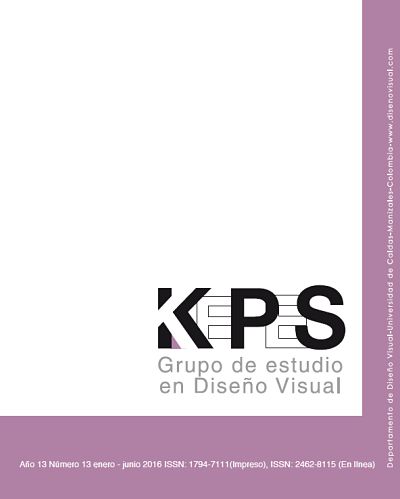Authors
Abstract
The results of the pertinence study conducted by the Academic ViceRector’s Office about the undergraduate Visual Design Program at Universidad de Caldas are presented in this article. Objective: to know the perception of the graduate students about institutional aspects such as the quality in their educational process, institutional and program competences. Methodology: descriptive research of non-experimental nature whose target population consisted of all the students graduated from the Visual Design program at Universidad de Caldas 2010 – 2014 (193 people). A non-probabilistic sample formed by 130 people who voluntarily answered the survey sent to their e-mails was taken. The Mann-Whitney U Test was used to carry out the comparisons between the valuations given by graduate students to the competences between what they perceive they have and what the working environment demands. Results: 76.2% of the graduate students are currently working, and 80.8% of them work as professionals in the field of visual design. 42.3% of the professionals found jobs in their discipline 11 months after graduation, and almost one third of the total (32.3%) were already working before their graduation. The visual designers of Universidad de Caldas work in institutions such as museums, city halls, universities, construction companies, design businesses, aviation enterprises, shopping malls, factories, etc. 72.3% of the professionals rate the academic quality of the Program as high or very high. Conclusions: the study found that the number of professionals that find working alternatives in enterprises of the region and the city of Manizales has increased. In general, the graduate students positively value the quality of the program, but it is necessary to offer short-term and medium-term programs (diploma courses, specializations), whose contents lead to the most recent issues in which the visual designers need training
References
Dias Sobrinho, J. (2008). Calidad, pertinencia y responsabilidad social de la Universidad Latinoamericana y Caribeña. Tendencias de la educación superior en América Latina y el Caribe, Caracas.
Gazzola, A. y Didriksson, A. (2008). Tendencias de la Educación Superior en América Latina y el Caribe. Caracas: IESALC-UNESCO
García, F. (2006). Una aproximación al concepto de universidad pertinente. Recuperado de: http://www.ucla.edu.ve/dac/investigaci%F3n/compendium5/pertinente.htm.
García, J. & Mendoza, G. (2002). Jóvenes, universidad y compromiso social. Una experiencia de inserción comunitaria. Madrid: Narcea.
Le Boterf, G. (2001). Ingeniería de las competencias. Barcelona: Gestión 2000.
Montaudon, C. (2010). Explorando la noción de calidad. Redalyc Acta Universitaria, 20(2), 50-56.
Perrenoud, P. (2004). La clave de los campos sociales: competencias del actor autónomo. En: En D.S. RychEn y L.H. SaLganiK (Eds.), Definir y seleccionar las competencias fundamentales para la vida (216-261). México: FCE.
Ruíz, F. (2010). Las competencias científicas en el contexto catalán, una mirada crítica al término y su conceptualización en la política educativa. Revista Latinoamericana de Estudios Educativos, 6(1), 75-93
Rychen, D. & Hersh, L. (2004). Definir y seleccionar las competencias fundamentales para la vida. México: Fondo de Cultura Económica.
Sheskin, D J. (2007). Handbook of parametric and nonparametric statistical procedures. 4th ed. Chapman & Hall/CRC, Boca Raton, FL.
Spencer, L.M. y Spencer, S.M. (1993). Competence at Work. New York: John
Wiley and Sons. Tamayo, O. (2001, Mayo). Evolución conceptual desde una perspectiva multidimensional. Recuperado de http://www.tdx.cat/TDX1015101-133217.
Torrado, M. C. (2000). Educar para el desarrollo de las competencias: una propuesta para reflexionar. En: Bogoya, D., Vinent, M., Restrepo G., Torrado,
M., Jurado, F., Pérez, M. et al. (2000). Competencias y Proyecto Pedagógico. (1a Ed.). (pp. 31-54). Bogotá: Unibiblos.
Tünnermann C. (2006). Guatemala. Recuperado de: http://biblio2.url.edu.gt:8991/libros/leccion%20inaugural2006texto.pdf
Tünnermann Bernheim, C. (2008). La calidad de la educación superior y su acreditación: la experiencia centroamericana. Evaluación Revista da Avaliação e da Educação Superior. (Campinas), 13, 313-336.
UNESCO. (1997). Documento de Política para el Cambio y el Desarrollo en la Educación Superior. Recuperado de http://www.unesco.org/education/pdf/24_235_s.pdf
Universidad de Caldas (2013). Documento de autoevaluación del programa de Diseño Visual.
Zabala, A., & Arnau, L. (2007). 11 ideas clave. Como aprender y enseñar competencias. Barcelona: Graó.

 pdf (Español (España))
pdf (Español (España))
 FLIP
FLIP





















